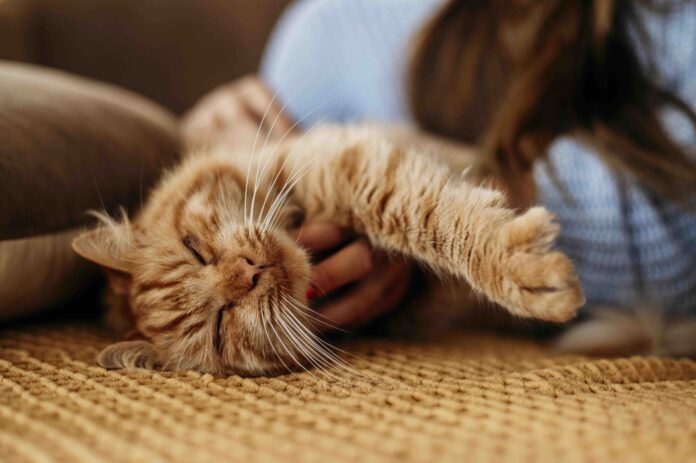Why Cats Make Great Pets
Cats are one of the most popular pets in the world, and for good reason. They are independent, self-sufficient animals that can bring joy and companionship into your life.
Unlike dogs, cats require less attention and care, but still offer unconditional love and affection. Cats are also known for their playful personalities and amusing antics.
Watching them chase after toys or lazily lounging in a sunny spot can put a smile on anyone’s face. Plus, studies have shown that owning a cat can lower stress levels and improve mood.
The Importance of Providing Proper Care for Cats
While cats may be low-maintenance pets compared to other animals, it’s still important to provide them with proper care. Neglecting their needs can lead to health issues or behavioral problems down the line. One of the most important aspects of cat care is feeding them a balanced diet that meets their nutritional needs based on age and weight.
Feeding your cat too much or too little can lead to obesity or malnutrition. Regular vet check-ups are also crucial for maintaining your cat’s health.
Vaccinations protect against common diseases while allowing the veterinarian to catch any potential health problems early on before they become more serious. In short, providing proper care for your cat not only benefits their well-being but also enriches your relationship with them as a beloved pet and loyal friend.
Feeding Your Cat
Types of Cat Food Available
When it comes to feeding your furry friend, there are a few different options to consider. Wet food, dry kibble, and even raw food diets are all available for cats. Wet food is typically higher in moisture content and can be beneficial for cats who struggle with drinking enough water.
Dry kibble, on the other hand, is more convenient to store and typically less expensive per serving. Raw diets can be more controversial due to the potential risk of bacterial contamination or malnutrition if not properly planned out.
Ultimately, the type of food you choose will depend on your cat’s individual needs and preferences. It’s always a good idea to consult with your veterinarian before making any significant changes to your cat’s diet.
How Much to Feed Your Cat Based on Age and Weight
Feeding your cat the appropriate amount is key to maintaining their overall health and wellbeing. The amount of food your cat needs will depend on their age, weight, activity level, and any underlying health conditions they may have.
As a general rule of thumb, adult cats should consume 2-4 small meals per day that add up to around 200-300 calories total. Kittens may require more frequent feedings throughout the day due to their smaller stomachs.
It’s important not to overfeed your cat as obesity can lead to a host of health problems down the line. On the flip side, underfeeding can also be dangerous as it can lead to malnutrition and poor immune function.
Tips for Feeding Picky Eaters
If you’re struggling with a picky eater, there are a few things you can try in order to entice them back into eating regularly. First off, try switching up the type or brand of food you’re offering – sometimes it’s just a matter of finding the right flavor or texture that your cat prefers.
You can also try warming up your cat’s food slightly to enhance the aroma and make it more appealing. Adding a little bit of water or chicken broth can also help to entice picky eaters.
If none of these interventions work, it’s always a good idea to reach out to your vet for additional advice. They may be able to recommend appetite stimulants or other medications if necessary.
Keeping Your Cat Healthy
Regular Vet Check-Ups and Vaccinations
Just like humans need regular check-ups to ensure our health and well-being, cats do too. It’s important to take your furry friend to the vet at least once a year for a check-up, even if they don’t show any signs of illness.
During these visits, the vet will conduct a physical examination to make sure your cat is in good health and may recommend vaccinations if necessary. Vaccinations are an essential part of keeping your cat healthy as they protect against common feline diseases such as feline distemper, rabies, and feline leukemia.
The vaccines needed will vary depending on your cat’s age, lifestyle (indoor vs outdoor), and overall health. Your vet can create a vaccination schedule tailored specifically to your cat’s needs.
Importance of Spaying/Neutering
Spaying or neutering your cat can have numerous health benefits in addition to preventing unwanted litters. Female cats who are spayed are less likely to develop uterine infections or breast tumors later in life, while male cats who are neutered have a lower risk of testicular cancer.
In addition to these health benefits, spaying or neutering can also help reduce certain behavioral issues such as territorial marking and aggression. It’s recommended that you spay or neuter your cat around 6 months old before they reach sexual maturity.
Common Health Issues in Cats and How to Prevent Them
Cats can be prone to certain health issues such as dental disease, obesity, diabetes, fleas/ticks/heartworms, kidney disease, urinary tract infections (UTIs), and more. To prevent these common ailments from affecting your furry friend: – Feed them a healthy diet that meets their nutritional needs
– Provide plenty of fresh, clean water – Regularly groom your cat and keep their litter box clean
– Use flea/tick preventative treatments as recommended by your vet – Keep up with regular vet check-ups and vaccinations
In addition, be aware of any changes in your cat’s behavior or physical appearance. If you notice anything out of the ordinary, don’t hesitate to contact your vet. Early detection and treatment can make a huge difference in your cat’s health and well-being.
Creating a Safe Environment for Your Cat
Indoor vs. Outdoor Cats: Which is Better?One of the biggest debates among cat owners is whether to keep their feline friends indoors or allow them to roam outside. While both options have their pros and cons, many experts agree that keeping cats indoors is safer and healthier in the long run. Indoor cats are protected from outdoor dangers such as traffic, predators, and diseases. They are also less likely to get into fights with other animals or get lost. However, some argue that outdoor cats lead happier lives because they have more space to explore and exercise. If you decide to let your cat go outside, make sure they are properly vaccinated and spayed/neutered. You should also provide them with a collar and identification tag in case they wander too far from home.
Making Sure Your Home is Safe for Your Cat
Whether your cat spends most of their time indoors or outdoors, it’s important to make sure your home is safe for them. This means removing any potential hazards such as toxic plants, cleaning supplies, electrical wires, or sharp objects that your cat could ingest or injure themselves with. You should also secure any open windows or balconies to prevent falls.
Additionally, make sure your home has plenty of hiding places and elevated surfaces for your cat to climb on or nap in. Cats love vertical spaces such as shelves, bookcases, and window sills where they can observe their surroundings from above.
Providing Scratching Posts and Toys
Cats naturally love scratching things – it’s a way for them to mark their territory and maintain healthy claws. Instead of letting your cat scratch up your furniture or carpeting, provide them with a variety of scratching posts and pads made of different textures such as sisal rope or corrugated cardboard.
Toys are also important for keeping your cat mentally stimulated and physically active. Cats love playing with toys that mimic prey such as feathers, laser pointers, or balls.
You can also invest in puzzle toys that challenge your cat’s problem-solving skills and encourage them to hunt for treats. By creating a safe and stimulating environment for your cat, you will ensure that they live happy and healthy lives both indoors and outdoors.
Grooming Your Cat
Just like humans, cats need regular grooming to stay healthy and looking their best. While cats are known for being self-sufficient when it comes to grooming, there are a few things you can do to keep their coat shiny and smooth.
Brushing your cat’s fur
Brushing your cat’s fur is an essential part of grooming. Not only does it help prevent hairballs, but it also helps distribute natural oils throughout their coat, keeping it soft and healthy.
Use a soft-bristled brush or comb specifically designed for cats, starting at the head and brushing towards the tail in the direction of hair growth. If your cat has long hair, you may need to brush them more frequently – up to once a day – to prevent matting.
Short-haired cats can get away with brushing once or twice a week. Don’t forget to give them treats and praise during grooming sessions so they learn to associate it with positive experiences!
Bathing your cat (if necessary)
Cats are known for being fastidious groomers but sometimes there may be situations when they need a bath if they have rolled in something stinky or have fleas or ticks that won’t come off with brushing alone. If you do decide that bathing is necessary, use lukewarm water and specially formulated shampoo designed for cats – not human shampoo as this can cause skin irritation.
Make sure not to get water in their ears as this can cause infection. Dry them off thoroughly using towels if possible as loud blow dryers can scare some cats; however if using one is essential then use low heat setting that doesn’t make too much noise
Trimming nails
Cats are known for their sharp claws, but you can help keep them from scratching up your furniture by trimming their nails regularly. Use a pair of specially designed cat nail clippers and be sure to only cut the tip of the nail, avoiding the pink area where nerves and blood vessels are located.
If you’re not comfortable doing it yourself, take them to a professional groomer or veterinarian. Make sure to give your cat treats and praise after every grooming session to encourage good behavior and make it a positive experience!
Understanding Your Cat’s Behavior
Cats are known for their quirky and unpredictable behavior. Understanding your feline friend’s body language and other behaviors is essential for creating a deeper bond with them. One of the most important things to pay attention to is your cat’s body language.
A cat’s tail, ears, eyes, and posture can all communicate different emotions. For example, if your cat’s tail is puffed up like a bottle brush, it means they are feeling threatened or scared.
If their ears are flat against their head, it means they are anxious or agitated. On the other hand, if your cat is purring while kneading on your lap, it means they are content and relaxed.
Body Language and What It Means
A cat’s body language can also indicate whether they want to play or be left alone. For instance, if your cat approaches you with their tail up in the air and starts to rub against you with their head or cheeks, it means they want attention or affection from you. However, if they flatten their ears back and swish their tail from side to side rapidly while staring at something intensely, it may mean that they are hunting prey (even if there’s nothing there!).
It’s essential to observe your cat’s body language carefully so that you can learn what each gesture means in different situations. This way you can respond appropriately to keep them happy.
Common Behaviors Such as Meowing, Purring and Kneading
Cats communicate through various sounds such as meows, purrs, hisses or even chirps! Each sound has a different meaning; for example:
– A meow might mean that they want food – A purr might mean that they’re content
– Hissing could be a warning sign that they’re feeling threatened Kneading is another common behavior in cats, and it usually means they’re feeling happy and relaxed.
Kneading is when they push their paws in and out on a soft surface, like your lap or blanket, almost like kneading dough. This behavior might be a sign of affection or that they need comfort.
Vocalizations That Indicate Pain or Discomfort
It’s important to pay attention to vocalizations that indicate pain or discomfort. Cats are notorious for hiding their pain, so if your cat starts meowing loudly or excessively, it could be a sign that something is wrong. Other signs of discomfort include hissing or growling when touched in certain areas, changes in appetite or litter box habits.
If you notice any sudden behavioral changes in your cat, it’s always best to consult with your vet to rule out any underlying health issues. Remember that understanding your cat’s behavior takes patience and observation but will be rewarding once you bond with them!
Conclusion
Summary of Key Points
Taking care of a cat requires dedication, patience, and love. To ensure that your feline friend is healthy and happy, you must provide them with nutritious food, regular vet check-ups, a safe environment to live in, grooming sessions, and an understanding of their behavior. By following these essential tips for cat care 101 you can create a bond with your pet that will last forever.
To keep your cat well-fed and healthy, offer them the right type of food based on their age and weight. Make sure they receive regular check-ups at the vet to spot any health issues early on and prevent them from becoming more serious problems.
Keep an eye out for common health problems specific to cats such as dental issues or urinary tract infections. Creating a safe environment for your cat means making them feel comfortable in their own space.
Provide scratching posts so they can keep their claws sharp while saving your furniture from damage. Toys are also essential in keeping their minds stimulated when you’re too busy to play with them.
Final Thoughts on the Joys of Owning a Happy, Healthy Cat
There’s nothing quite like coming home after a long day at work or school to be greeted by the purring of your furry feline friend. Owning a happy and healthy cat brings so much joy into our lives–from playing with them to cuddling up together on the couch. Caring for cats requires time and effort but it is ultimately rewarding as it helps establish an unbreakable bond between owner and pet.
Remember that every cat is unique and will require different types of care. By following these essential tips for Cat Care 101: Essential Tips for Keeping Your Feline Friend Happy and Healthy you’ll ensure that you have many years ahead filled with love from your furry companion!



